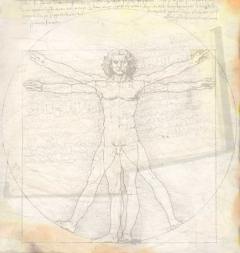|
The chant section goes like this:
O Lono, Lono, Lono-ka-eho!
Lono descended from the gods, chief of the fertile land of Nana,
Here are canoes, come aboard,
Return and dwell on green-backed Hawaii,
A land discovered in the ocean,
Risen up out of the waves,
From the very depths of the sea,
A piece of white coral left dry in the ocean,
Caught by the hook of the fisherman,
The great fisherman of Kapaahu,
The great fisherman Kapuheeuanuu,
When the canoes land, come aboard,
Sail away and possess Hawaii; a land,
A land is Hawaii,
A land is Hawaii for Lonokaeho to dwell in.
The chant is repeated below with the words/phrases that appear to be clues to
a wider and/or deeper meaning noted -
O Lono, Lono, Lono-ka-eho(1)!
Lono descended from the gods, chief of the fertile land of Nana(2),
Here are canoes, come aboard,
Return and dwell on green-backed Hawaii,
A land discovered in the ocean,
Risen up out of the waves,
From the very depths of the sea,
A piece of white coral left dry in the ocean,
Caught by the hook of the fisherman,
The great fisherman of Kapaahu(3),
The great fisherman Kapuheeuanuu(4),
When the canoes land, come aboard,
Sail away and possess Hawaii; a land,
A land is Hawaii,
A land is Hawaii for Lonokaeho to dwell in.
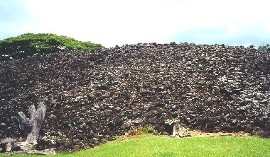
(1) Lono-ka-eho.
Eho means "pile of stones." Each land section
of each of the Hawaiian Islands was marked at its border with an ahu, a piled stone altar, with an image of a pua'a, pig.
(Thus the name for these land sections - ahupua'a.) And pig is one of Lono's forms.
Heiau - temples - were also built using piles of stones. Not all heiau
involved Lono worship, but the one pictured here, Ulupo Heiau, did/does, and you can see that it takes a mighty pile of stones
to build a heiau.
I also have an inkling, maybe it's something I read somewhere, that stones are
stars or stars are stones. I think that's sort of as in "(some) stones stand for stars."
(2) the land of Nana.
Nana has several meanings per Pukui's Dictionary. The meaning most people
know is 'look to/at." I don't think that's its meaning here.
Nana is equivalent to ana, and that makes this "land of Nana" a very special
place. The dictionary says that ana is to measure, survey, fathom; survey, measurement, standard, design, plan, meter,
gauge.
That's really important. It means that Lono comes from the land/home/source
of the measures, the very center of the abyss-whirlpool, and it probably also means, at least by inference, that Lono
brings the measures with him from the abyss.
And the abyss/whirlpool is where? It's Po, the otherworld/ Underworld,
the realm of potentiality - Kanaloa's realm, which is, at least ritually/spiritually speaking, the kohe, the womb of the universe,
Kohe Malamalama O Kanaloa.
(3) the great fisherman of Kapaahu.
Kapa-ahu was my first thought - tapa(barkcloth) altar, tapa cape. Nah.
Ka-paa-(a)hu. The - foundation, stratum, border - heap, pile, mound, altar,
cairn-shrine. In other words, the marked boundary of the earth/heavens.
Also, the word pa by itself means enclosure. It also means to blow (as
wind), to shine (as sun), to beat or sound a rhythm, and a signal to begin a dance.
(4) the great fisherman Kapuheeuanuu.
Kapu - sacred, he'e - octopus (Kanaloa's best-known body form), ua - (a particle
indicating the verb following is a completed action - in other words, kind of like "was" in English) -nuu - heights, stratum.
So, The Sacred Octopus-Kanaloa Who Has Come Down From the Heights-Heavens.
I wonder - is there another octopus-body deity? I'm kind of thinking there
probably is.
There is, of course, more.
Lono-kaeho is a god with eight stone foreheads.
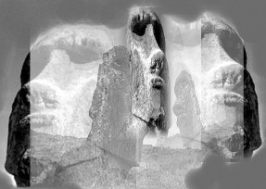
Eight stone foreheads. Stone piles. Eight
piles of stones? Eight cliffs? Eight stone walls? altars? boundary markers? There it is! Isn't
it?
(Lo - front of a skull (Pukui and Elbert Dictionary)) But maybe Lono's
stone foreheads are . . .

. . . adzes, stone adzes like the one in the picture
just above
and the one attached by twine to a handle just below
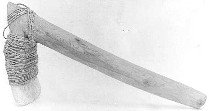
The dictionary doesn't have a Hawaiian word
listed for the English word "solstice," but there is a word for it. There has to be, quite obviously as there are many
heiau and ahu throughout the islands that have solstice alignments and solstice markers.
I think the word for solstice is "ko'i," the word Rubellite Johnson uses
for both the sun's northern limit and its southern limit. And "ko'i" is also the word for "adze."
There were special Hawaiian priests called "adze-headed priests,"
and they were solstice priests.
\/\/\/\/\/\/\/\/\/\/\/\/\/\/\/\/\/\/\/\/\/\/\/\/\/\/
+++++++++++++++++++++++++++++++++++++++++++
>>>>>>>>>>>>>>>>>>>>>>>>>>>>>>>>>>>>>>>>>>>
Sidebar:
Until 1300 AD chiefs and priests from throughout Polynesia made the sea voyage to a heiau in Tahiti called Taputapuatea (in
Hawaiian - Kapukapuakea, and in either language "very sacred deity" literally translated.) Here they met as the council
for the federation of Polynesian islands/tribes/peoples/nations. This is not the kind of material one finds in
history books, but there are a couple of written sources from early to mid 20th Century. The books, however, are out
of print.
There's another such meeting
place as well. And there's a reason there are two meeting places. The Pacific Ocean is a big place, and the people
who lived on its islands didn't divide themselves into three discreet ethnic groups of Melanesians, Polynesians, and Micronesians.
There was overlap, such as those islands in Micronesia which ethnogeography now calls "Polynesian outliers."
One could reasonably say
that the southwestern half of the Polynesian islanders met at Taputapuatea and the northwestern half met at the other place.
The other place is Kahoolawe, near Hakioawa on the part of the island facing the island of Maui.
That Kahoolawe meeting place,
and even the fact that there was such a place, doesn't show up in books. But there are people who know about it, generally
because their family histories incorporate it in some way.
I was having a conversation
with a retired social science professor much of whose work has been involved with Hawaiian "wayfinding."
I mentioned the Taputapuatea councils, and asked if he knew about the other councils, the ones that met at Kahoolawe.
He said he'd heard some people mention it, but there isn't anything in the literature that refers to it.
Earlier that day I'd read
a San Francisco Chronicle article touting the publication of a peer-reviewed journal article that says a linguistic study
of Hawaiian and Chumash languages provides near-proof of pre-columbus contact between Hawaiians and the Chumash.
Well. How is this
news? I mean, I know it's news that a peer-reviewed journal is publishing the piece because mainstream academia has
not just pooh-poohed the notion of such contact but virtually placed the kiss of academic death on any researcher who claimed
the contact occurred.
But the Chumash have always
known. So have Hawaiians. And so have the Haida, the Lummi, the Pit River, and on and on and on.
So I guess my patience was
already stretched thin. I didn't say anything untoward to the professor, but I was really angry. What a people
know of their own culture isn't something validly known because no one with academic credentials wrote it down and got it
published. Phooey.
Somebody is always the first
to write something and get it published. Then it's accepted. But if some prof had heard the same information from
a person who lives the tradition and culture the information wouldn't be valid because it hasn't been published, unless, of
course, the prof was the one writing for publication.
*********************************************************************************************
--------------------------------------------------------------------------------------------------------------------

This is uala, the sweet potato vine, another
of Lono's forms.
Lono also has representations in petroglyph forms. One of these, is
a T-cross, pretty clearly representing the Makahiki pole. One version of this petroglyph is below. 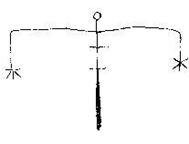
Another Lono petroglyph is in the form of a humpbacked man blowing a conch
shell trumpet. That's the little black figure with rust background that appears at the bottom of Catasterize web pages.

|
